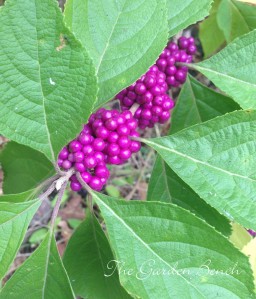A friend gave us a cutting from a beautyberry shrub a couple of years ago, and the new shrub bloomed and produced berries for the first time this year. When can we take cuttings to plant more of them?
 You can increase your plantings of American beautyberry (Callicarpa americana) by taking softwood stem cuttings in summer or fall, according to the USDA Plants Database. Cut 4” – 6” long stems, dip the cut ends into rooting hormone and stick them into potting mix or other rooting media. Water the cuttings and cover them with plastic to keep the material moist. Roots should develop in a few weeks.
You can increase your plantings of American beautyberry (Callicarpa americana) by taking softwood stem cuttings in summer or fall, according to the USDA Plants Database. Cut 4” – 6” long stems, dip the cut ends into rooting hormone and stick them into potting mix or other rooting media. Water the cuttings and cover them with plastic to keep the material moist. Roots should develop in a few weeks.
After rooting begins, remove the plastic for longer intervals each day for a week or so, finally removing it permanently. Plant the rooted cuttings and water them well.
The mature fruit — those beautiful berries — can also be planted in the fall to germinate next spring.
Beautyberry, which also goes by the names sourbush, bunchberry and French mulberry, is an easy-to-grow perennial shrub that is native to the U.S. Several special of birds are drawn to the purple berries in late summer and fall, as are squirrels, raccoons, possums and deer.
And interesting note from the USDA Plant Database: farmers in the early 20th century crushed the leaves and rubbed them on themselves to repel mosquitoes and other biting bugs. Native American cultures also used the roots, leaves and branches for medicinal purposes, to treat malarial fevers, rheumatism, stomach aches, dysentery and colic.
October in the garden: Click here for a list of October garden tips & tasks.
Filed under: Plant propagation, Shrubs | Tagged: American beautyberry, Callicarpa america, purple berries | Leave a comment »





